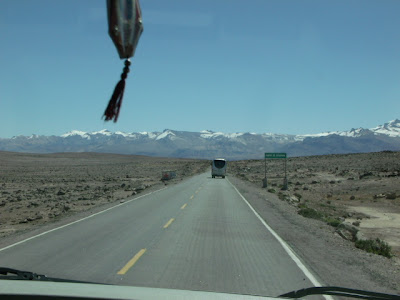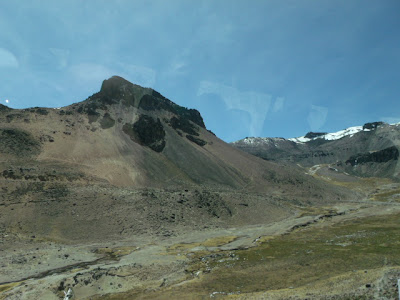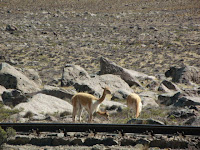To get from Arequipa to the Colca Valley one leaves the city and skirts around Chachani volcano, following the Arequipa-Juliaca highway, and then takes the turn-off toward Colca. On the way to Colca one must cross the Salinas y Aguada Blanca National Reserve.
The reserve encompasses 366,936 hectares and contains a number of fresh- and salt-water lakes and ponds -for which it is named- plus bogs and other high-altitude wetlands, as well as dry puna, volanic deposits, and snow-capped volcanoes. It was created in 1979 in order to protect the fauna, flora, and natural
landscape of the area, and in particular to preserve habitat for
vicuñas and guanacos - wild relatives of the domesticated llamas and
alpacas.
The average elevation is above 4,000 meters a.s.l. - for example, at one spot where we stopped for a break the elevation was 4,225 m. (13,861 ft. a.s.l.), and at the Mirador de los Volcanes the road passes 4,910 m. (16,108 ft. a.s.l.). Having been in Arequipa for a couple of days already seemed to have helped a bit with the altitude.
ICEFALL
At one point along the way the road passes through the blown-out caldera of an extinct volcano. While that's pretty impressive in itself, it is made even neater by a rather large icefall beside the road.
VICUÑAS
ICEFALL
At one point along the way the road passes through the blown-out caldera of an extinct volcano. While that's pretty impressive in itself, it is made even neater by a rather large icefall beside the road.
VICUÑAS
For the visitor, even ones just passing through, one of the primary attraction of the national reserve of Salinas y Aguada Blanca is the chance to see some wild vicuñas.
Vicuñas live in small herds of one male and a handful of females. Young males are kicked out of the herd, and wander for a while, until they establish herds of their own or they are strong enough to chase off another male and take over his harem.
The vicuña is a wild cousin of the llama and the alpaca, and is one of two nondomesticated South American camelids - the other being the guanaco, which also inhabits the reserve but is rarely seen. Vicuñas wool is among the finest in the world, and a garment made from it can easily fetch (US)$1000 or more. The vicuña population in Salinas y Aguada Blanca is managed by the peasant communities within the reserve, who annually gather the animals for shearing, and patrol the reserve against poachers the rest of the year.
We were lucky enough to spot vicuñas both, on the way to, as on the way from, Colca.
Vicuñas live in small herds of one male and a handful of females. Young males are kicked out of the herd, and wander for a while, until they establish herds of their own or they are strong enough to chase off another male and take over his harem.
Which means that this individual was likely a male a year-old or thereabouts.
VIZCACHAS
Another animal which occurs at those altitude, and which is normally quite shy as well, is the vizcacha. Being usually described as similar in appearance to a rabbit, but really being much more like a chinchilla, vizcachas nest in crevices and spaces in between and under rocks throughout the Peruvian Andes. They are sometimes hunted for their pelts and for food.
We were lucky, on our way back to Arequipa, to catch some sunning themselves on the rocks piles that had been left from clearing the roadbed through the Patapampa plateau, at above 4,800 meters a.s.l. (15,750 ft.).























No comments:
Post a Comment